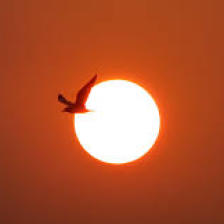When Editor Renée told us to write about “light,” James went superluminous.
By James Zheng
Light has a really miraculous existence within the realm of physics. We understand light’s form to be more a ray than a physical entity, and, generally, we describe it as both particles and waves due to its property of spreading easily and still bouncing off of objects. Scientists have discovered plenty of other marvelous phenomena about the nature of light. The phenomenon I like the most is the light boom.
What is a light boom? We’ll get there. First, I want to introduce you to the idea of a similar phenomenon called a sonic boom. A sonic boom occurs when the speed of an object exceeds the speed of sound. There will be strong air resistance, which causes strong oscillation and speed decay. When breaking through the sound barrier, the compression of the air caused by the speeding object doesn’t allow the air to spread easily. The air gradually accumulates in the windward area of the object and finally forms a shock wave, on which the kinetic energy is highly concentrated. These energies are transmitted to people’s ears in the form of a strong explosion, and this is what is typically called a sonic boom. Simply put into layman’s terms, a sonic boom is just a situation in which the speed of the object goes beyond the speed of sound.
The light boom, similarly, is the effect of particles’ speed exceeding the speed of light. When the speed of moving charged particles exceeds the speed of light, a special phenomenon of light emission occurs.
However, the conditions to create a light boom are extremely difficult and cannot be achieved in a vacuum. When the phase velocity (Electromagnetic wave’s propulsion speed on a single-phase point), and group velocity (Electromagnetic wave’s propulsion speed on any phase points through spaces) of light in the medium decreases, it is possible for the moving charged particles to surpass the phase velocity of light. This phenomenon, generally, would only appear in the cooling water of nuclear reactors and would produce a very subtle blue light that can be seen with the naked eye. That blue light is a light boom.
Light booms were originally called Cherenkov Radiation. This radiation was discovered in 1934 by former Soviet Union physicist Pavel Alexeyevich Cherenkov; it was named after him.
Why is there such a huge difference between a sonic boom and the concept of a light boom? Since I found out the preexisting factors to trigger the sonic boom are way simpler than the light boom. If let’s say that a sonic boom is a phenomenon resulting from a speed faster than the speed of sound, then the light boom should have the same principle. But, when I discovered that there is no way of proving there could be a speed faster than the speed of light, my mind went to . . . superluminality–a speed that’s faster than light.
So, I went on researching any circumstances that could give proof to a superluminality, and all I found is the expansion of universes and black holes as the standard example of superluminality. All of those can only be seen in space; the technology we have so far cannot generate an artificial speed that goes faster than light.
Although there is not a “pure” or authentic man-made example of a light boom, we have discovered the expansion of universes and the existence of black holes to confirm the hypothesis of superluminality to at least recognize the existence of it. Once we have the ability to create superluminality by ourselves, we will witness the true light boom.

Light Editor: Renée Vazquez
Source Referenced:



